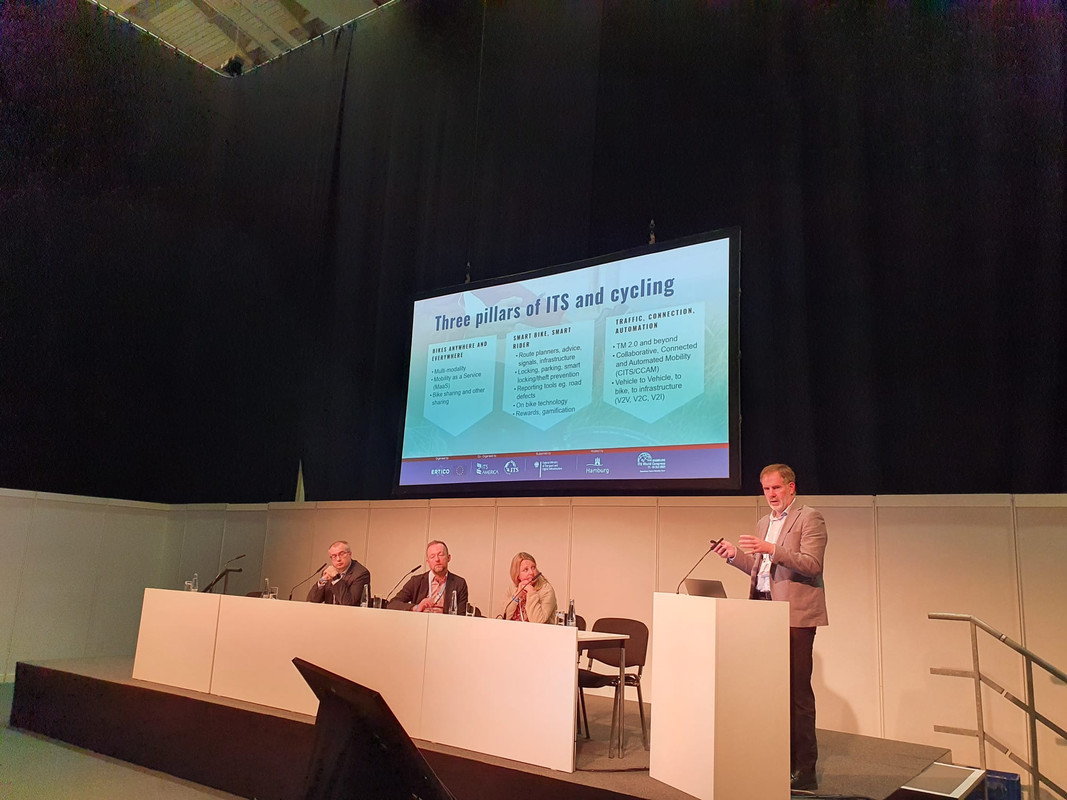The ITS World Congress is the largest event entirely dedicated to smart mobility and digitalisation of transport. Participants have the occasion to exchange ideas on smart mobility solutions among policy makers, industry experts, company leaders and the general public, discussing the latest developments in ITS, showcasing of cutting-edge technologies and innovations.
This first face-to-face ITS World Congress in two years brought together over 13,000 members of the ITS Community from more than 65 countries to share experiences and plans on the path to sustainable, safe and efficient mobility.
The theme of ITS Hamburg 2021 was ‘Experience Future Mobility Now’, bringing into focus what is being done today to deliver smart mobility around the world and what the leading-edge solutions are for tomorrow’s mobility challenges.

Only few years ago cycling had a very small space at ITS World Congresses, with very little consideration about the potential of digitalisation in improving the cycling experience. This year the cycling industry came out on top of the ITS eco-system, allowing attendees to exchange innovative ideas and best practices about bikes and ITS. Cycling had many slots within the program of the conference with high level sessions that involved the European Commission, MaaS, ERTICO, Cycling Industries Europe and the BITS project.
Here are five take-aways about the most interesting outcomes at ITS Hamburg 2021.
1. High level recognition of cycling in ITS
The overall focus of the Congress was not just on management and innovation as it was in the past, but it clearly targeted sustainability and modal shift in transport. The challenges posed by the fight against climate change and the reduction of CO2 emissions need an important contribution from the transport sector. Cycling is recognised as part of the solutions offered by a different approach to smart mobility and ITS.
The European Commission committed to include cycling and active mobility in the proposal for a review of the ITS Directive that will come out likely in mid-December. This highlights the great advocacy work that the cycling industry has done over the past few months with the EU institutions and the need to continue the dialogue in the coming months with the Commission, the EU Parliament and the Member States.
2. Data
The availability of quality cycling data standardised and harmonised within a common European framework is the big challenge of the coming years. The good news is that this need is recognised by all the actors involved in the process: the Commission, the Member States, local authorities and the cycling industry.
National transport data centres (known as National Access Points or NAPs) want cycling in that space and they are willing to include CIE in the discussions. During the session organised by CIE and BITS, the representative of the German NAP highlighted the lack of cycling data and the need to exchange about best practices. Other NAPs like the Dutch and the French are in close contact with CIE and agree to cooperate and set a roadmap on data work.
The Commission wants to commit more to cycling and support Member States to tackle the challenges on data by investing more money in the National Access Point Coordination Organisation for Europe (NAPCORE) program.

3. Awareness of cycling solutions
As mentioned before, local authorities in cities and municipalities consider cycling part of the solution for a sustainable and smart mobility. Decision makers are including more cycling in their urban policy plans and the addition of bike lanes is one of the top environmental transport measures being implemented in many cities. But these actions can be reinforced by the use of new technologies (i.e. route mapping applications, intelligent traffic lights, smart bike parking, etc.) and an efficient data management and analysis to make cycling even more attractive.
Demonstration projects like BITS show how ITS solutions can be integrated in urban mobility, improving cycling in many aspects such as safety and reliability, speed and convenience, comfort and experience. Thanks to this kind of projects, the cycling industry can get into the market and get more visible, building awareness of what can be offered and creating opportunities to work with local institutions.
4. Increasing demand for cycling in ITS solutions
The importance of cycling in reducing traffic congestion and interacting with the environment around is increasing and bikes are more and more involved in Traffic Management Systems and fields like Vehicle-to-Vehicle and Vehicle-to-Infrastructure. The cycling industry have a great opportunity to bring to the table innovative products and services and make the community aware of what cycling can do.
The BITS Directory goes in this direction, aiming to create a platform where industry and companies can showcase and promote their cycling-specific ITS products and services, and where municipalities can present their ITS implementations. This is a first step to resolve a long-standing issue that there are many cycling products and services emerging in the sector, but potential suppliers, customers and investors didn’t know where to find them.
The cycling industry needs to work more closely with ITS experts to further develop innovative cycling solutions. CIE is happy to announce two new members, GEWI and Spoke, that joined the Connected Cycling and ITS Expert Group, bringing their extensive knowledge and technical expertise in ITS.
5. MaaS
The last takeaway is about MaaS. Cycling is clearly part of the MaaS community and it’s well positioned inside the MaaS Alliance, but there is still a lot of work ahead. So far there are no concrete plans on a viable route for a sustainable business model. CIE will continue to bring the cycling perspective and be actively involved in MaaS Working Groups.
This ITS Congress has led to excellent outcomes for cycling and we are proud to be part of the movement that is bringing this sector on a completely different level as it was few years ago!
Share on Linkedin Share on Facebook Share on Twitter Subscribe to our newsletter